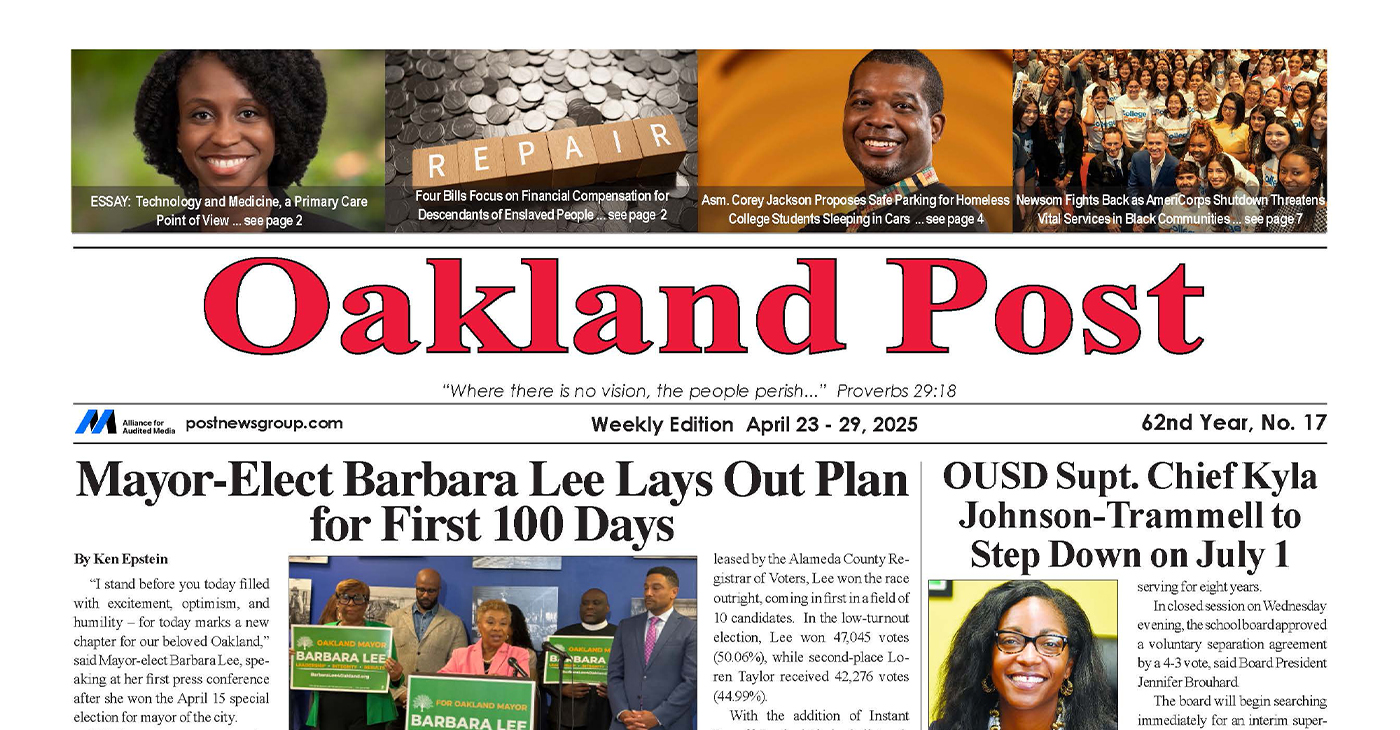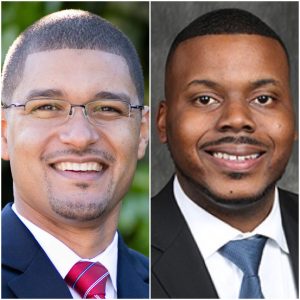Community
A Diverse Jury Delivers Justice for George Floyd
Right up to when the verdict was read the anxiety level was so high, people all over the country were fearful. This case was really the People vs. the Cops. Leave it to diversity.

All-white jury? There’s no more feared phrase among civil rights lawyers. But that’s not what Minnesota gave us in the Derek Chauvin trial. The jury that decided the fate of the white former police officer who had his knee on George Floyd’s neck was more diverse than the Minnesota county where the trial was held. And that means the odds of getting justice were probably a lot higher than anyone could have imagined.
Right up to when the verdict was read the anxiety level was so high, people all over the country were fearful. This case was really the People vs. the Cops. Leave it to diversity.
Minnesota’s Hennepin County has 1.3 million people, according to Census data from 2019. The racial breakdown is 74.2% are white, 13.8% black, 7.5% Asian, 7% Latino, 3.3% biracial, 1.1% Native American. How much lower would your anxiety level be with a 12-member jury that had only nine white people? Not much.
But again, praise diversity. The Chauvin jury included six whites — two male, four female. And there were four Black people (three of whom are male, plus a 60-year-old black woman). The remaining two jurors were multiracial. But now, what’s in their heads?
The questionnaires all the potential jurors filled out asked about policing, protests and criminal justice. Among the selected was a white man in his 20s, who was the only juror who said he had not seen the cell-phone video of Chauvin with his knee on Floyd’s neck. The man, a chemist, said in his questionnaire, “I rely on facts and logic and what’s in front of me.”
To me that sounded like a guy who might want to see some evidence again. That indicated to me the potential for a long deliberation and not a quick one.
One of the Black jury members, in his 30s, said he had not seen the cell-phone video in its entirety. In his questionnaire he said he didn’t believe Chauvin “set out to murder anyone,” but noticed how three officers on the scene stood by and didn’t take action.
It seemed to reflect a balanced, open-minded jury that could deliberate on the truth.
The prosecution skillfully framed its case around the cell-phone video we have all seen, the 9:29-long video of Chauvin with a knee to the neck of Floyd. “You can believe your eyes,” said attorney Jerry Blackwell in the opening. In closing, his prosecuting partner, Steve Schleicher, said it again and added, “This wasn’t policing. This was murder.”
In the end, the jurors did not allow themselves to be gaslit by the defense, who presented alternative facts as to how Floyd died. But jurors could see for themselves in that video: Chauvin wasn’t demonstrating “reasonable” policing.
The jury delivered guilty verdicts on all three complicated murder charges: second-degree unintentional murder; third-degree murder, and second-degree manslaughter. Trifecta.
To think Chauvin wanted to plead to at least 10 years, but former U.S. Attorney General William Barr wouldn’t approve it because there was fear that 10 wouldn’t be seen as severe enough. Now Chauvin, whose bail was revoked and sent back into custody, could get up to 40 years.
A triumph for the people. And for diversity. A system so biased toward the cops was beaten. It happens.
Savor it peacefully and think of others who have come up empty-handed in their quest for justice. Let this be an energizing reminder, how alive justice can make us all feel.
Emil Guillermo is a journalist and commentator. See his vlog at www.amok.com Twitter @emilamok FB @emilguillermo.media
Activism
Oakland Post: Week of April 23 – 29, 2025
The printed Weekly Edition of the Oakland Post: Week of April 23 – 29, 2025

To enlarge your view of this issue, use the slider, magnifying glass icon or full page icon in the lower right corner of the browser window.
#NNPA BlackPress
Chavis and Bryant Lead Charge as Target Boycott Grows
BLACKPRESSUSA NEWSWIRE — Surrounded by civil rights leaders, economists, educators, and activists, Bryant declared the Black community’s power to hold corporations accountable for broken promises.

By Stacy M. Brown
BlackPressUSA.com Senior National Correspondent
Calling for continued economic action and community solidarity, Dr. Jamal H. Bryant launched the second phase of the national boycott against retail giant Target this week at New Birth Missionary Baptist Church in Atlanta. Surrounded by civil rights leaders, economists, educators, and activists, Bryant declared the Black community’s power to hold corporations accountable for broken promises. “They said they were going to invest in Black communities. They said it — not us,” Bryant told the packed sanctuary. “Now they want to break those promises quietly. That ends tonight.” The town hall marked the conclusion of Bryant’s 40-day “Target fast,” initiated on March 3 after Target pulled back its Diversity, Equity, and Inclusion (DEI) commitments. Among those was a public pledge to spend $2 billion with Black-owned businesses by 2025—a pledge Bryant said was made voluntarily in the wake of George Floyd’s murder in 2020.“No company would dare do to the Jewish or Asian communities what they’ve done to us,” Bryant said. “They think they can get away with it. But not this time.”
The evening featured voices from national movements, including civil rights icon and National Newspaper Publishers Association (NNPA) President & CEO Dr. Benjamin F. Chavis Jr., who reinforced the need for sustained consciousness and collective media engagement. The NNPA is the trade association of the 250 African American newspapers and media companies known as The Black Press of America. “On the front page of all of our papers this week will be the announcement that the boycott continues all over the United States,” said Chavis. “I would hope that everyone would subscribe to a Black newspaper, a Black-owned newspaper, subscribe to an economic development program — because the consciousness that we need has to be constantly fed.” Chavis warned against the bombardment of negativity and urged the community to stay engaged beyond single events. “You can come to an event and get that consciousness and then lose it tomorrow,” he said. “We’re bombarded with all of the disgust and hopelessness. But I believe that starting tonight, going forward, we should be more conscious about how we help one another.”
He added, “We can attain and gain a lot more ground even during this period if we turn to each other rather than turning on each other.” Other speakers included Tamika Mallory, Dr. David Johns, Dr. Rashad Richey, educator Dr. Karri Bryant, and U.S. Black Chambers President Ron Busby. Each speaker echoed Bryant’s demand that economic protests be paired with reinvestment in Black businesses and communities. “We are the moral consciousness of this country,” Bryant said. “When we move, the whole nation moves.” Sixteen-year-old William Moore Jr., the youngest attendee, captured the crowd with a challenge to reach younger generations through social media and direct engagement. “If we want to grow this movement, we have to push this narrative in a way that connects,” he said.
Dr. Johns stressed reclaiming cultural identity and resisting systems designed to keep communities uninformed and divided. “We don’t need validation from corporations. We need to teach our children who they are and support each other with love,” he said. Busby directed attendees to platforms like ByBlack.us, a digital directory of over 150,000 Black-owned businesses, encouraging them to shift their dollars from corporations like Target to Black enterprises. Bryant closed by urging the audience to register at targetfast.org, which will soon be renamed to reflect the expanding boycott movement. “They played on our sympathies in 2020. But now we know better,” Bryant said. “And now, we move.”
#NNPA BlackPress
The Department of Education is Collecting Delinquent Student Loan Debt
BLACKPRESSUSA NEWSWIRE — the Department of Education will withhold money from tax refunds and Social Security benefits, garnish federal employee wages, and withhold federal pensions from people who have defaulted on their student loan debt.

By April Ryan
Trump Targets Wages for Forgiven Student Debt
The Department of Education, which the Trump administration is working to abolish, will now serve as the collection agency for delinquent student loan debt for 5.3 million people who the administration says are delinquent and owe at least a year’s worth of student loan payments. “It is a liability to taxpayers,” says White House Press Secretary Karoline Leavitt at Tuesday’s White House Press briefing. She also emphasized the student loan federal government portfolio is “worth nearly $1.6 trillion.” The Trump administration says borrowers must repay their loans, and those in “default will face involuntary collections.” Next month, the Department of Education will withhold money from tax refunds and Social Security benefits, garnish federal employee wages, and withhold federal pensions from people who have defaulted on their student loan debt. Leavitt says “we can not “kick the can down the road” any longer.”
Much of this delinquent debt is said to have resulted from the grace period the Biden administration gave for student loan repayment. The grace period initially was set for 12 months but extended into three years, ending September 30, 2024. The Trump administration will begin collecting the delinquent payments starting May 5. Dr. Walter M. Kimbrough, president of Talladega College, told Black Press USA, “We can have that conversation about people paying their loans as long as we talk about the broader income inequality. Put everything on the table, put it on the table, and we can have a conversation.” Kimbrough asserts, “The big picture is that Black people have a fraction of wealth of white so you’re… already starting with a gap and then when you look at higher education, for example, no one talks about Black G.I.’s that didn’t get the G.I. Bill. A lot of people go to school and build wealth for their family…Black people have a fraction of wealth, so you already start with a wide gap.”
According to the Education Data Initiative, https://educationdata.org/average-time-to-repay-student-loans It takes the average borrower 20 years to pay their student loan debt. It also highlights how some professional graduates take over 45 years to repay student loans. A high-profile example of the timeline of student loan repayment is the former president and former First Lady Barack and Michelle Obama, who paid off their student loans by 2005 while in their 40s. On a related note, then-president Joe Biden spent much time haggling with progressives and Democratic leaders like Senators Elizabeth Warren and Chuck Schumer on Capitol Hill about whether and how student loan forgiveness would even happen.
-

 Activism4 weeks ago
Activism4 weeks agoOakland Post Endorses Barbara Lee
-

 Activism4 weeks ago
Activism4 weeks agoOakland Post: Week of March 28 – April 1, 2025
-

 Activism3 weeks ago
Activism3 weeks agoOakland Post: Week of April 2 – 8, 2025
-

 #NNPA BlackPress3 weeks ago
#NNPA BlackPress3 weeks agoTrump Profits, Black America Pays the Price
-

 Activism2 weeks ago
Activism2 weeks agoOakland Post: Week of April 9 – 15, 2025
-

 #NNPA BlackPress3 weeks ago
#NNPA BlackPress3 weeks agoHarriet Tubman Scrubbed; DEI Dismantled
-

 #NNPA BlackPress3 weeks ago
#NNPA BlackPress3 weeks agoLawmakers Greenlight Reparations Study for Descendants of Enslaved Marylanders
-

 #NNPA BlackPress3 weeks ago
#NNPA BlackPress3 weeks agoTrump Targets a Slavery Removal from the National Museum of African-American History and Culture





















































